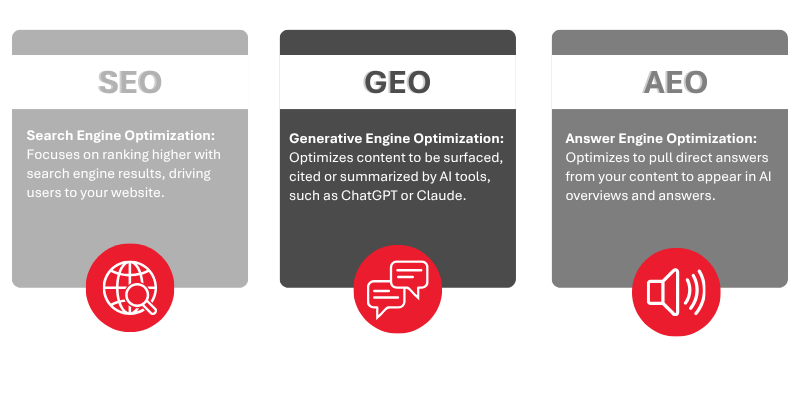
Search is evolving fast, and AI platforms like ChatGPT and Gemini are supplanting traditional search engines as users’ first destination for information. Nearly 1 in 4 Americans now start their shopping and learning searches with ChatGPT, and 3 in 10 surveyed report they trust it more than search engines. ChatGPT now owns 80% of AI search traffic, so to stay competitive, your brand needs to show up where the questions are being asked and answered.
Why AI Visibility Matters
If your brand’s content isn’t present or optimized for these platforms, you risk missing an important early influence moment. Research shows Gen Z and Millennials are especially likely to turn to AI assistants, making this a key channel for reaching emerging and future buyers.
Here’s how to optimize your content to show up where it counts.
Understanding how AI Platforms and AI-Powered Answers Work
- AI-powered answer engines combine and rank information to deliver the most useful response.
- They rely on public data and, like search engines, still value relevance, authority, and context.
- They use reasoning, memory, and real-time data to form answers.
- Because they adapt to context, the same question can yield different results over time.
- Built for conversation, they learn from follow-ups and refine their responses.

6 Ways to Create AI-Friendly Content
- Answer Real Questions
When creating content, think about how your audience actually searches. Content that directly answers real questions is more likely to match the kind of queries people type into search bars and the natural language prompts they use.
Tip: Use Q&A formats and long-tail keywords that mirror natural queries: “How do I apply for a home equity loan” or “What’s the best bedtime routine for toddlers?”
- Keep It Clear and Skimmable
AI models favor structured, digestible content. The models are all designed to provide the most relevant, helpful response.
Tip: Short paragraphs, bullet points, and clear headers help readers and make it easier for AI platforms to parse and return your information as answers.
- Build Authority
Stronger authority means your content is more likely to be referenced. Content should demonstrate expertise, give context, and use natural language, so AI considers it trustworthy.
Tip: Cite reputable sources, use relevant statistics, and include expert voices to signal trustworthiness.
Your AI content strategy starts here.
We’ll help you find your footing – and your audience.
STIR It Up- Stay Accessible and Add Value
Content hidden behind PDFs, gated downloads, or paywalls is less likely to be crawled and surfaced. Additionally, Google is tightening its standards on low-quality content, penalizing sites that rely on AI-written, copied, or thin pages, as well as fake backlinks or expired domains.
Tip: Publish helpful blogs, FAQs and guides on your website, ungated, to maximize visibility. If your site traffic has dropped, Google’s crackdown on low-quality content could be to blame. Audit your site and remove weak pages, add credible sources, and focus on trustworthy, people-first content.
- Write How Users Search
SEO helps your content rank in search results, while Generative Engine Optimization (GEO) ensures AI tools like ChatGPT surface, cite, or summarize it in answers. AEO focuses on making your content easy for answer engines to pull directly. They overlap—but differ in where and how your content appears. It’s important to optimize accordingly, but keyword stuffing won’t do.
Tip: Write in a conversational, natural style that reflects how people speak. Strategically weave in relevant conversational key phrases.
- Prioritize Graphics, Videos and Reviews
Generative answer engines draw from written, visual, and interactive content. To rank in AI-driven search, brands must go beyond blogs and create valuable content assets, including video and interactive tools. Third-party listings and strong reviews also matter, as answer engines favor credible, neutral sources.
Tip: When creating a new asset, ask, “Would this help someone quickly understand or decide?” If the answer is yes, it’s likely to boost your visibility.
Future-proof your strategy with STIR
AI Platforms like ChatGPT and Gemini are reshaping how people discover and consume content. To stay visible, brands need to prioritize helpful, structured, and trustworthy resources that can be easily understood and referenced by both humans and AI.
Want to future-proof your strategy? Reach out to Brian Bennett at bbennett@stirstuff.com. We’ll help you craft content that connects with your audience and appears where they’re looking.



